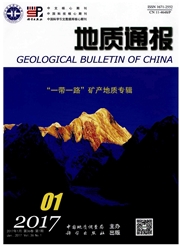

 中文摘要:
中文摘要:
东北大兴安岭地区的五一岩体主要由正长花岗岩、碱长花岗岩组成,通过系统的SHRIMP U—Pb测年和地球化学研究。对其成因进行约束。结果表明,五一岩体中锆石发育震荡生长环带,且具有较高的Th/U比值(0.43-0.57),反映其为岩浆成因锆石,SHRIMPU—Pb定年结果为299Ma+3Ma,表明该岩体的形成时代为早二叠世。五一岩体的SiO2和K2O含量分别介于77.63%-81.83%和3.64%-5.1%之间,全碱(K2O+Na2O)含量为6.43%-8.02%,碱度率(AR值)为3.18-3.62;该类岩石富集轻稀土元素和Th、Nd、Rb、K等元素,明显亏损Ba、sr、P和Ti等元素。上述特征表明,五一岩体为后造山Ⅰ型花岗岩,形成于伸展的构造背景。
 英文摘要:
英文摘要:
The Wuyi intrusion, located in the Da Hinggan Mountains, is mainly composed of orthogranite and alkali feldspar granite. Chronological and geochemical studies of the Wuyi intrusion was carried out in order to constrain their petrogenesis. Zircons from the intrusion display oscillatory zoning and high Th/U ratios (0.43 to 0.57), implying its magmatic origin. Zircon SHRIMP U-Pb dating of the Wuyi intrusion indicates that it was formed in early Permian with the age of 299Ma±3Ma. Its SiO2 and K2O content range from 77.63% to 81.83% and 3.64% to 5.1%, respectively, the K2O+Na2O and the A.R are in the range of 6.43% to 8.02% and 3.18 to 3.62. Moreover, the Wuyi intrusion is enriched with light rare earth dements as well as Th, Nd, Rb and K but markedly depleted in Ba, St, P and Ti. It is inferred that the Wuyi intrusion belongs to post-orogenic Ⅰ-type granite formed in an extensional tectonic setting.
 同期刊论文项目
同期刊论文项目
 同项目期刊论文
同项目期刊论文
 期刊信息
期刊信息
